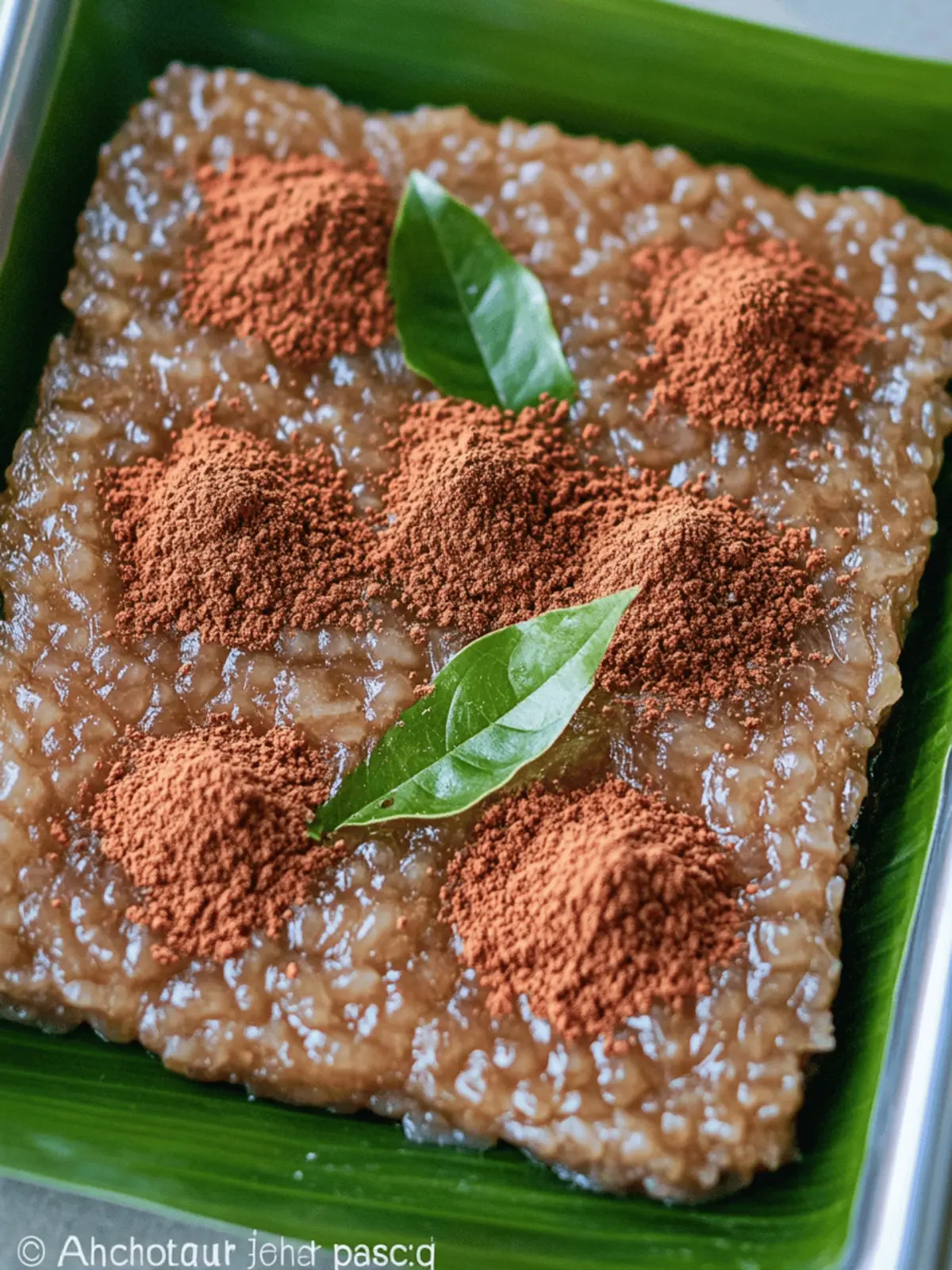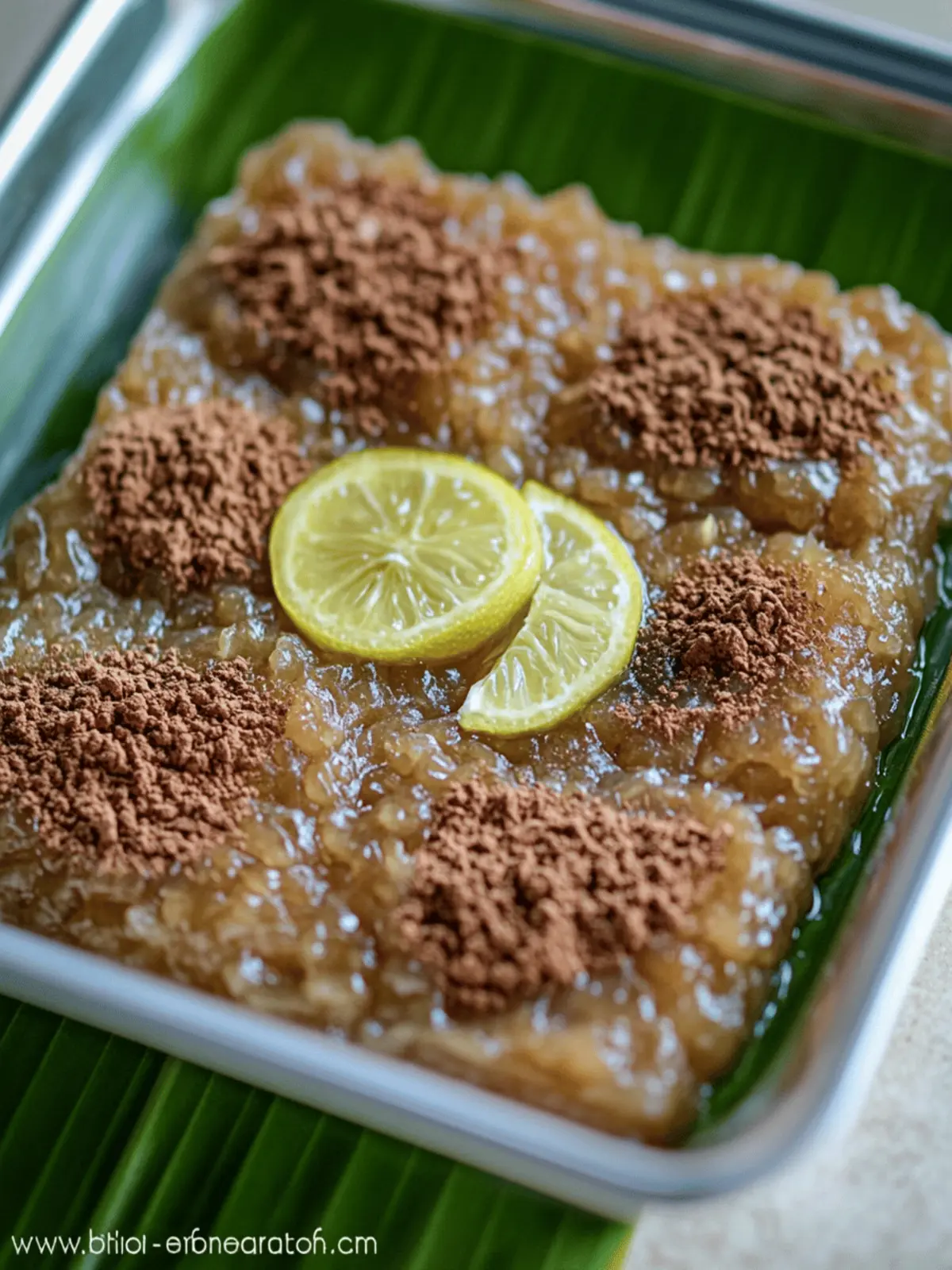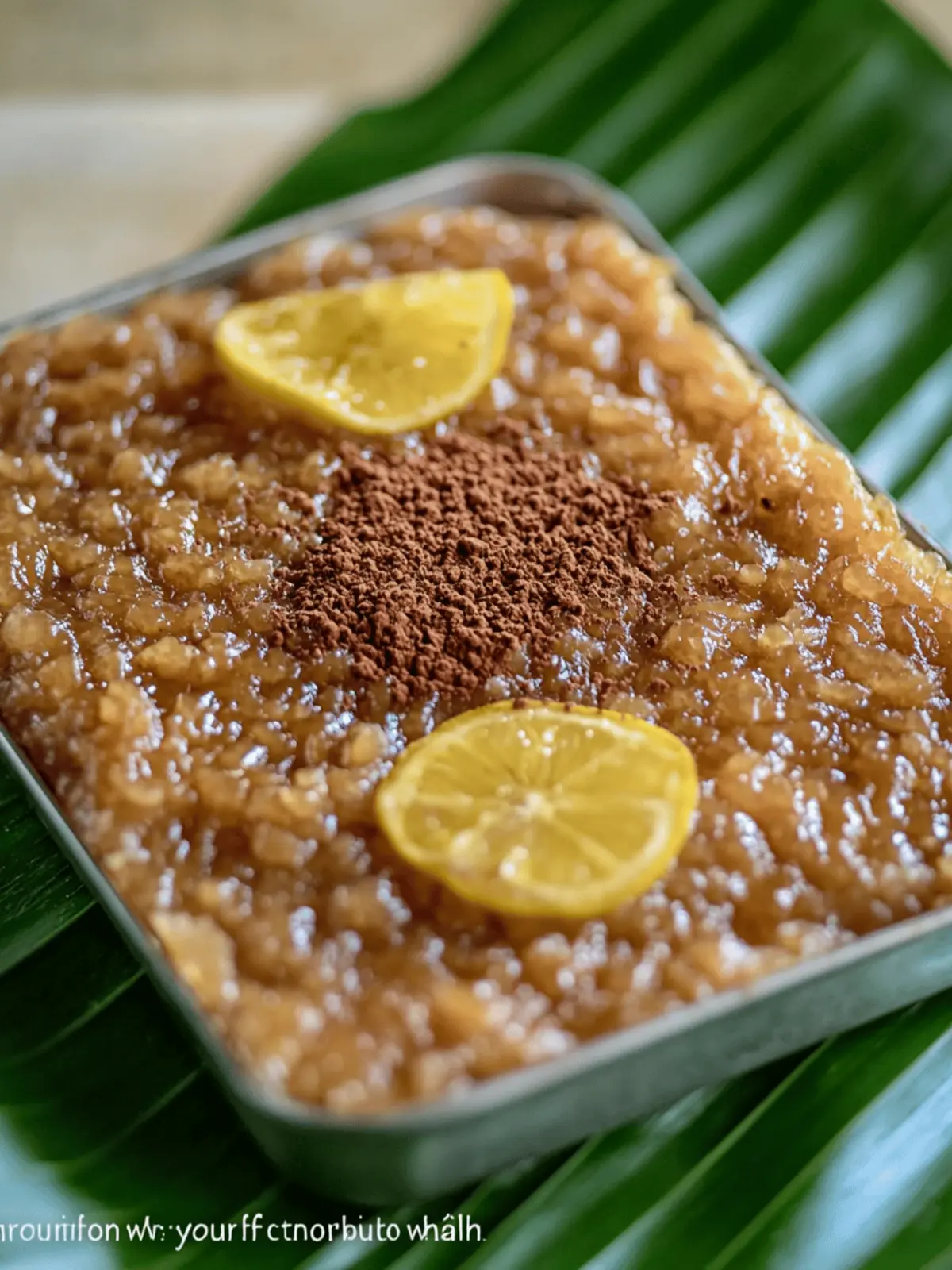A warm, inviting aroma of coconut fills the air as I step into the kitchen, just as my grandmother did when she prepared her famous Biko for family gatherings. This delightful Filipino sticky rice cake, with its rich coconut flavor and sweet, chewy texture, has a special place in my heart. Each bite transports me back to sunny fiestas and joyful celebrations surrounded by loved ones. What I adore about Biko is not just its flavor but its simplicity—it comes together from just a handful of ingredients you likely already have in your pantry.
Whether it’s a Tuesday night or a festive holiday, this traditional kakanin promises to uplift your spirits and satiate those cravings for something homemade and comforting. Plus, with variations like Chocolate Biko and Ube Biko to explore, there’s always a new twist to discover! Ready to indulge? Let’s dive into this beloved recipe and bring a slice of Filipino culture to your table!
Why is Biko the ultimate comfort food?
Comforting aroma: The warm scent of coconut and sweet rice fills your kitchen, instantly evoking nostalgia and warmth.
Simple preparation: With just a few ingredients, you can create a lush dessert that’s both satisfying and easy to make.
Versatile variations: Feel free to experiment with flavors—whether you choose Chocolate Biko or Ube Biko, the creativity is endless!
Gluten-free delight: This traditional Filipino treat is naturally gluten-free, making it a fantastic option for those with dietary restrictions.
Crowd pleaser: Perfect for gatherings, Biko brings friends and family together, making any occasion feel festive and special.
Nostalgic connection: Each bite not only tastes good but also carries stories of celebration from Filipino culture, adding joy to your dining experience.
Biko Ingredients
For the Sticky Rice
• Glutinous Rice (Malagkit) – This is essential for the characteristic chewiness of Biko; regular rice won’t provide the same texture.
• Water – Needed to cook the glutinous rice and create the perfect sticky consistency.
For the Coconut Mixture
• Coconut Milk – The star ingredient that brings creaminess and rich flavor; to lighten it, you can use light coconut milk.
• Brown Sugar – Adds sweetness and a lovely caramel note; substitute with coconut sugar for a different taste.
• Salt – A tiny dash enhances the sweetness; adjust to your preference.
With these simple yet meaningful ingredients, you’re well on your way to crafting the delicious and traditional Biko, a true treasure of Filipino dessert culture!
How to Make Biko
-
Combine 2 cups of glutinous rice and 1.5 cups of water in a rice cooker. Cook until the rice is tender and slightly undercooked, giving it that perfect chewy texture.
-
Mix 4 cups of coconut milk, 2 cups of brown sugar, and 0.5 tsp of salt in a saucepan. Stir over low heat for about 20 minutes until the mixture thickens beautifully.
-
Combine the cooked glutinous rice with the thickened coconut milk mixture. Mix thoroughly to ensure every grain is well-coated in that luscious coconut goodness.
-
Cook on low heat until most of the liquid evaporates. Be careful not to overcook; you want it sticky yet structured!
-
Transfer the mixture to a serving plate, flattening the surface gently. Let it cool slightly before slicing and serving this delightful dessert.
Optional: Serve warm with a sprinkle of latik on top for an extra treat!
Exact quantities are listed in the recipe card below.
Expert Tips for Making Biko
-
Perfect Texture: Always use glutinous rice for the signature chewy texture of Biko; regular rice won’t work.
-
Watch the Mixture: Stir the coconut milk mixture constantly to prevent burning and ensure it thickens properly—patience is key!
-
Avoid Overcooking: Keep a close eye on the rice; it should be only slightly undercooked before mixing with the coconut mixture for the best results.
-
Sugar Adjustments: If you prefer a less sweet Biko, start with less sugar and add to taste, since it’s traditionally quite sweet.
-
Serving Warm: For the best experience, serve Biko warm, optionally topped with latik which adds a delightful crunch and flavor!
What to Serve with Biko?
Indulge in an array of flavors and textures that elevate your Biko experience to a new level of delight.
-
Coffee or Hot Chocolate: The rich, creamy notes of Biko harmonize beautifully with a warm cup of coffee or hot chocolate, creating a cozy pairing.
-
Fresh Mangoes: Juicy, sweet mango slices perfectly complement the sticky sweetness of Biko, adding a refreshing contrast that brightens every bite.
-
Coconut Flan: For a double dose of coconut, pair with silky coconut flan. The smooth texture and slight sweetness enhance the traditional flavors of Biko.
-
Sliced Bananas: Soft, ripe bananas bring a natural sweetness that melds well with the chewy texture of Biko, making for a comforting combo you’ll love.
-
Latik Topping: Drizzle with latik (coconut curds) for a crunch that pairs with the creamy nature of Biko. This addition amplifies the dish’s authenticity and flavor.
-
Warm Coconut Soup: Enjoy a comforting bowl of warm coconut soup alongside Biko for a soothing finish. The lightness of the soup contrasts nicely with the heaviness of the rice cake.
-
Fruit Salad: A colorful fruit salad with a touch of lime juice adds zing and freshness that balances the sweetness of Biko, making the meal well-rounded and satisfying.
-
Pineapple Juice: Sipping on refreshing pineapple juice while enjoying Biko enhances the tropical flair of this delightful dessert, balancing its sweetness with a zesty tang.
Make Ahead Options
Planning to enjoy Biko without the last-minute rush? You can prepare several components ahead of time, making it an ideal option for busy cooks! Cook the glutinous rice up to 24 hours in advance; simply let it cool and store it in an airtight container in the refrigerator. The coconut mixture can also be prepared ahead – cook and cool it, then refrigerate for up to 3 days. When it’s time to serve, reheat the rice and coconut mixture gently in a saucepan, stirring until combined and warm. This way, you’ll have a fresh, homemade Biko that’s just as delicious and comforting as if made from scratch on the spot!
Biko Variations
Feel free to unleash your creativity and personalize this delicious dessert to suit your taste buds!
-
Latik Topping: Add a layer of crispy latik for a delightful crunch that contrasts beautifully with the soft, sticky texture.
-
Chocolate Biko: Stir in cacao tablea or cocoa powder into the coconut mixture, creating a rich, chocolatey treat that chocolate lovers will adore. Enjoy the vibrant color and unique flavor!
-
Ube Biko: Mix in ube halaya for an exciting purple twist and a hint of earthy sweetness, making your Biko both visually stunning and deliciously unique.
-
Coconut Flakes: Toasted coconut flakes can be sprinkled on top for an added crunch and enhanced coconut flavor that elevates each bite.
-
Mango Swirl: Incorporate fresh, ripe mangoes into the mixture or use as a topping, resulting in a tropical fruitiness that brightens the rich flavors of Biko.
-
Cinnamon Spice: A dash of cinnamon can be introduced to the coconut mixture, adding a warm, spicy note that perfectly complements the sweetness.
-
Banana Leaf Wraps: Consider wrapping the sticky rice in banana leaves for an authentic touch; this not only makes for a beautiful presentation but adds a subtle aroma.
-
Maple Syrup Drizzle: For a unique variation, drizzle pure maple syrup over the finished Biko for a sweet twist that adds a depth of flavor to this beloved Filipino classic.
How to Store and Freeze Biko
Room Temperature: Biko can be kept covered at room temperature for up to 3 days; this maintains its chewy texture while allowing the flavors to meld.
Fridge: For longer storage, refrigerate Biko in an airtight container for up to 1 week. Just ensure it’s well-covered to prevent drying out.
Freezer: To freeze, cut Biko into portions, wrap tightly in plastic wrap, and place in a freezer-safe bag for up to 2 months.
Reheating: When ready to enjoy, gently reheat Biko in the microwave or steam it for a few minutes; this helps restore its delightful sticky texture.
Biko Recipe FAQs
What type of glutinous rice should I use for Biko?
Absolutely! Make sure to use glutinous rice (malagkit) for authentic Biko. Regular rice won’t give you that characteristic sticky and chewy texture. You can find glutinous rice at most Asian grocery stores or online. Look for brands that specifically state “malagkit” for the best results.
How long can I store Biko, and what’s the best method?
For optimal enjoyment, store Biko covered at room temperature for up to 3 days. If you want to extend its life, pop it in the refrigerator where it’ll last up to 1 week. Just ensure to keep it airtight to avoid drying out. Gently reheat before serving for that delightful, warm experience.
Can I freeze my Biko? If so, how?
Very! To freeze your Biko, first, cut it into manageable portions. Then, wrap each piece tightly in plastic wrap and place them in a freezer-safe bag. It can be frozen for up to 2 months. When you’re ready to enjoy, simply reheat in the microwave or steam for a few minutes to restore its delightful stickiness.
What if I overcook the rice?
No worries—everyone has been there! If your rice ends up overcooked and mushy, it might not slice as beautifully. To remedy this, try mixing in a little more coconut milk or sugar to give it a fresh flavor boost. To salvage the texture, you might also consider turning it into a decadent dessert by pressing it into a mold and serving it with a scoop of ice cream.
Are there any dietary restrictions I should be aware of with this recipe?
Definitely! It’s wonderful that Biko is naturally gluten-free, making it suitable for those with gluten sensitivities. However, the primary ingredients include coconut milk and brown sugar; if you’re allergic to coconut or need to avoid sugar, you might want to explore alternative recipes or adjustments. For example, you could try using almond milk or sweeteners like stevia, but keep in mind the flavor and texture may change.
Can I make variations of Biko while still staying true to the recipe?
Absolutely! The beauty of Biko lies in its versatility. You can create Chocolate Biko by adding cacao to that luscious coconut mixture, or go colorful with Ube Biko by mixing in some sweet ube halaya. Don’t hesitate to experiment, as there’s no right or wrong way to enjoy this delicious treat!

Sweet Biko Bliss: Easy Filipino Sticky Rice Cake Recipe
Ingredients
Equipment
Method
- Combine 2 cups of glutinous rice and 1.5 cups of water in a rice cooker. Cook until the rice is tender and slightly undercooked.
- Mix 4 cups of coconut milk, 2 cups of brown sugar, and 0.5 tsp of salt in a saucepan. Stir over low heat for about 20 minutes until the mixture thickens beautifully.
- Combine the cooked glutinous rice with the thickened coconut milk mixture. Mix thoroughly to ensure every grain is well-coated.
- Cook on low heat until most of the liquid evaporates.
- Transfer the mixture to a serving plate, flattening the surface gently. Let it cool slightly before slicing and serving.








